“A man too busy to take care of his health is like a mechanic too busy to take care of his tools.”
Before we begin, let’s replace a few words in your “fitness” vocabulary:
- Replace TRANSFORMATION with JOURNEY
- Replace EXERCISE with TRAINING
- Replace DIET with NUTRITION
- Replace REST with RECOVERY
If you already have the right words in your vocabulary, you will find much more value reading the rest of this article.
If not, you will always be stuck in the loop of trying to go on and off diet plans and workout programs just like I did before.
That said, let’s get started.
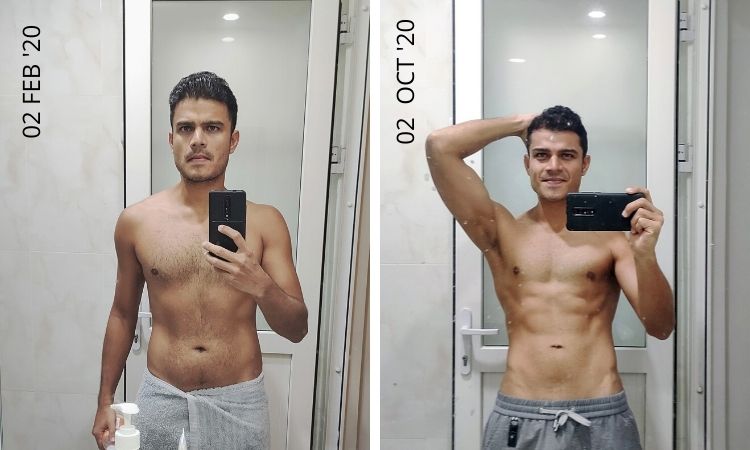
Table of Contents
THE MINDSET
Before we start our fitness journey, we must walk the path in our heads.
Every journey starts in your mind.
It is said that You must win the war in your head before actually going to war.
So what’s the right mindset for fitness? First, we’re not going through a transformation, which usually means there is an end goal. Most people chasing a look will usually work until they get it and then lose their progress if at all, they can make it to their end goal.
So If you’re looking for a transformation, you’re chasing the wrong goal.
Here’s what really worked for me:
Focus on building healthy habits into your daily life rather than obsessing over a specific transformation goal. Once you do this, your transformation will become a milestone in your lifelong fitness journey.
This is the most important mindset you need to develop before embarking on any journey. Prepare for the journey and your goals will become milestones on the journey.
I’ve found this true for developing skills, growing your finance, as well as becoming stronger and healthier.
If you’re with me so far and ready to build habits that will automate your fitness goals, the next question is what are the habits or tools that I should adopt into my lifestyle to lead a healthier life?
“When health is absent, wisdom cannot reveal itself, art cannot become manifest, strength cannot be exerted, wealth is useless, and reason is powerless.” – Herophiles
Before we get into the content, remember that just like you, I’m a student of fitness and I’m just sharing what I’ve learned so far into my fitness journey.

Well, let’s break down all the habits and tools into 3 categories. These 3 together make up “the tripod stand” of fitness:
The Tripod Stand of Fitness
- TRAINING (not exercise)
- NUTRITION (not diet)
- RECOVERY (not rest)
Here’s the difference:
- Training vs Exercise: Training is actually developing yourself and improving your fitness skills and not just a round of movements that burn calories or get a pump in.
- Nutrition vs Diet: Nutrition is focusing on getting all the right nutrients that your body needs to perform and grow rather than sticking to a short term diet plan that you can follow only for a while.
- Recovery vs Rest: Recovery is actually getting your body back to being ready to perform rather than just getting a nap or lazy hours in.
We can refer to these as the 3 key pillars of fitness which together make up the tripod stand of fitness. If any of these pillars don’t have a strong foundation, the stand is bound to fall. The question then is, how to strengthen these pillars. Just like anything else we become better at in life, it takes daily practice and small incremental progress to become good at the pillars of fitness.
Blood, sweat, and respect. First two you give. Last one you earn. – Dwayne ‘The Rock’ Johnson
Let’s deep dive into each of the pillars now.
PART 1: TRAINING
The only 2 things you need in your training are:
- Favorable Execution
- Progressive Overload
Let me explain both these concepts.
What is “Favorable Execution” in Training?
“Favorable Execution” means that your life’s circumstances and environments will favor the execution of the training of your choice. Let me give you a few examples of this:
- A local gym with basic equipment that’s a 5-minute walk from your house will “favor execution” of your training more than an international gym with lots of facilities that is a 30-minute drive away.
- If you cannot move outside your house, a bodyweight training will “favor execution” much more than making a training dependant on going to the gym.
- If you enjoy doing more flowy workouts like yoga or dance, then a yogic or dance training will “favor execution” much more than weight training.
- If you enjoy outdoor workouts like calisthenics, then making that your primary training will “favor execution” much more than joining a Zumba class.
- If you live in the center of the city with no access to parks around you and your training is based mostly on outdoor jogging and cycling, then changing your environment to the countryside or in natural surroundings will “favor execution” more than trying to push yourself in environments you don’t enjoy.
- If you don’t enjoy running but love walking, then including long walks in your training will favor execution much more than trying to force yourself to run.
The above examples mean that you should pick something that you enjoy doing, that you have access to, and that suits your environment (or change your environment to match your choice) of training.
“Fitness: if it came in a bottle, everybody would have a great body.”
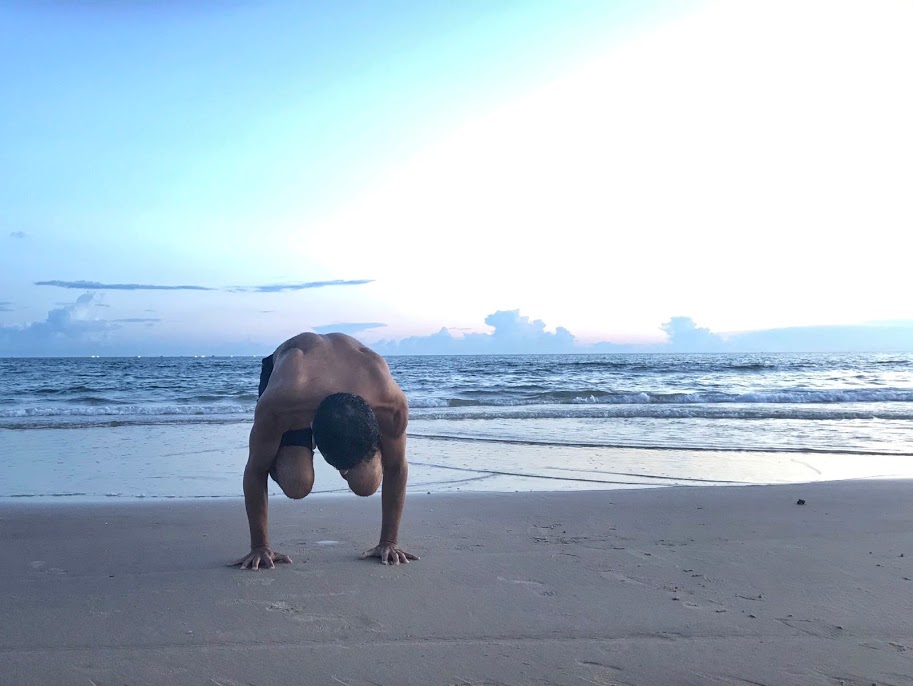
You shouldn’t just follow the training your friend-who-is-ripped is following or your favorite celebrity is doing. Pick something you enjoy and you can execute forever.
What is “Progressive Overload” in Training?
If you’ve read my content or taken my courses on Productivity, you know I talk about being 1% better every day or small improvements and habits and their compound effect as being the core of productivity.
Similarly, progress overload in training means going beyond what your body is comfortable with and pushing your limit slightly in each training session.
“If it Doesn’t Challenge You, It Doesn’t Change You.”
Progressive overload is easier to add in some training compared to others. I started my fitness journey with only yoga and walking, later added jogging and basic bodyweight movements, followed by running and calisthenics, and finally added strength training as well.
Basically, I picked trainings I like, pushed my limits each time, and added new training schedules I found interesting which could make it easier for me to progressively overload my trainings.
Let’s explain this with an example:
When I started my fitness journey in February 2020, I couldn’t perform a slow pushup with proper form. In yoga, the yogic pushup and flows helped me improve my push strength to a good level. I also practiced the regular pushup until I got the form right.
Next, I added progressive overload by increasing the number of pushups I could do.
I also added progressive overload by slowing down the speed of pushups, holding it for a longer time to increase what is called muscle “time under tension”. I then slowed down further and focused more on each concentric and eccentric part of the movement.
Further, I added progressive overload by doing multiple sets of push up reps, adding a weighted jacket in my calisthenics routine.
“The difference between try and triumph is a little umph.” – Marvin Phillips
I recently added the bench press to my routine and had a head start from all the previous push strength I had developed. And now I find it much easier to progressively overload my push workouts by just adding weights in the gym.
In my cardio workouts, I started with just walking 10,000 steps a day (which is a habit I complete every day), moved to jogging 2kms to jogging 2kms with sprints in between, to jogging 5kms, to jogging kms with sprints in between.
There are ways to progressively overload any movement but in some trainings, it’s just more obvious than others.
Now that we know what are the components of training, we should also understand what we’re training for.
You can train for any of the following or all of these:
- STRENGTH
- HYPERTROPHY
- FLEXIBILITY
- MOBILITY
- CARDIOVASCULAR ENDURANCE
- MUSCULAR ENDURANCE
You can define what you value more and train accordingly:
- STRENGTH can be related to lifting heavy,
- HYPERTROPHY can be related to the size of your muscles,
- FLEXIBILITY is related to the ability of muscles to lengthen and stretch,
- MOBILITY is related to the joints and their ability to move actively through the full range of motion,
- CARDIOVASCULAR ENDURANCE is the ability of your heart and lungs to fuel your body with oxygen for prolonged periods of time,
- MUSCULAR ENDURANCE is the ability of your muscles to work continuously without getting tired.
In general, we all need mobility to move along life and mobility is quite easy to train with warmups, cooldowns, and some key full-body movements.
Almost everything else on the list can be adjusted based on your personal goals. It’s good to have some hypertrophy, strength, flexibility, and endurance but, to be very honest, these are not things you NEED a lot of to live an overall healthy life.
With that established, let’s get into my trainings of choice and how I train.
“Only the disciplined are truly free. The undisciplined are slaves to moods, appetites, and passions.” – Stephen Covey
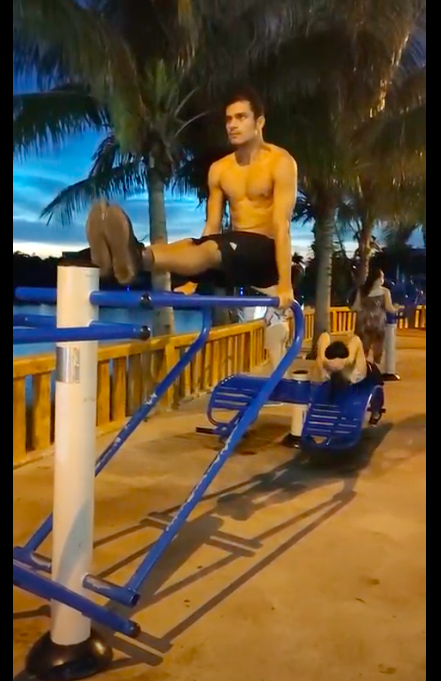
My trainings of choice:
- YOGA (Focus areas: Flexibility and Mobility)
- CALISTHENICS (Focus area: Muscle endurance)
- CARDIOVASCULAR TRAINING (Focus area: Cardiovascular endurance)
- WEIGHT TRAINING (Focus areas: Strength and Hypertrophy)
I don’t get into the debate of which one is better. I enjoy all these types of training and incorporate all of them into my routine. As you can see, I have defined the focus areas for each training. While each training can offer growth in multiple areas, I have chosen my priority areas of focus for each of them.
For example, you can also train yoga for strength but I’d rather do that in the gym and keep my yoga sessions to push my flexibility (which I need a lot of work on) and mobility.
Similarly, calisthenics can get some hypertrophy, but I like to engage in longer, more flowy calisthenics sessions to improve endurance. I also like to spend less time in the gym, which is good, as I only have gym sessions for strength and hypertrophy (which doesn’t need a lot of reps and time that would be needed if I train in the gym for endurance).
Lastly, I like to do long outdoor cardio sessions like long swims and jogs and increase my time and distance each time – basically training for Cardio endurance.
You might also observe that I didn’t focus on trainings for goals like weight loss or flat stomach etc as those are just milestones on the overall journey to fitness. I realized a few weeks into the journey that I should focus on components of fitness rather than specific goals that didn’t have any long-term meaning.
Let’s see each training in further detail:
YOGA
“Yoga is not just be performed; yoga is to be lived.”
I started my fitness journey with yoga and that’s all I did for the first few months. I found an amazing online yoga teacher, Meher, who trained me through one-on-one online classes. Her Instagram is @meheronfire where you can also find the link to enquire about her personal classes.
You will instantly see her amazing physique on her IG and I would like to add that her understanding of her students and the ability to guide them to make progress is perfect.
The rest would be up to you and how much you practice.
“The pose begins when you want to leave it.”
We focused our sessions on vinyasas or flows and even though I now workout on my own, I still follow the vinyasas we practiced together and learn new ones from YouTube.
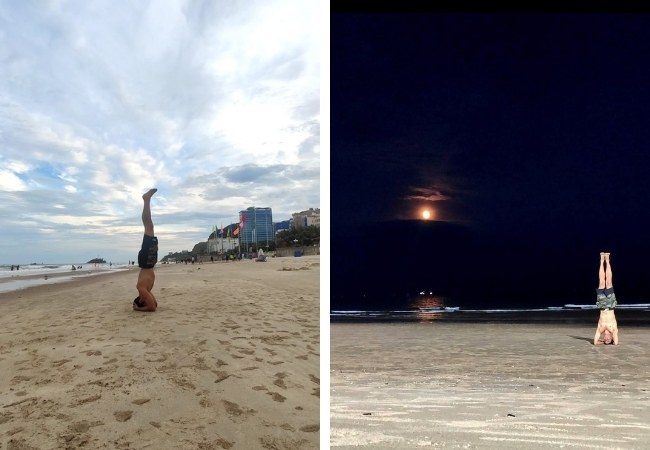
2 of my favorite YouTubers for follow-along Vinayasa sessions are Allie – The Journey Junkie and Xuan Lan Yoga (also helps practice some Spanish).
I found 20-30 minute yoga sessions (preferably in the morning) to be optimal for my day. Under 20 minutes, I don’t feel the satisfaction and above 30 minutes, it starts affecting the rest of my daily routine – unless I don’t have any other training planned for the day.
I also make sure I do some breath work and meditate for 10 minutes after I practice yoga.
When I miss the yoga routine in the mornings, I cover up for it in the evening time or during beach time 🙂
CALISTHENICS
“If you move, your body will allow more movement.”
If I were to choose only one style of training from the list for the rest of my life, it would definitely be calisthenics.
The good thing however, is that we don’t need to choose just one style of training.
You carry your body weight everywhere and be able to achieve amazing ways of moving your body that you never knew you could do before.
Even though the scope of progressive overload is not as obvious as it is in weight training or resistance training, it still has enough scope to keep you extremely fit and in very good shape for life.

The best part about Calisthenics is you don’t need a lot of equipment for practice. Almost all parks around the world have the simple hanging bar for Calisthenics and the parallel dip bars. Most of the moves can be done with this setup.
“Trying out new ways of using your body breaks you free from old ways of thinking and being.”
In fact, for a lot of work, especially push work, you don’t even need this basic setup. I had started doing pushups indoors and the Australian pull-ups on my work desk even before I could do my first real pull-up in the Calisthenics park.
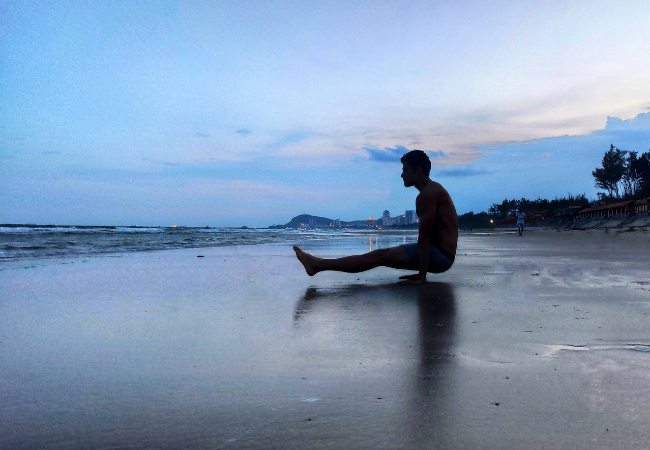
You can focus on all muscle groups and split your calisthenics training routine into PUSH, PULL, LOWER BODY days. The CORE is always engaged in Calisthenics as you need to use the core when you perform natural compound bodyweight movements.
However, I prefer each of my Calisthenics training sessions to be full-body sessions. I do split my gym days into PUSH, PULL, LEGS (3 sessions per week) which we will discuss in the Weight Training section.
If you want to learn Calisthenics, this YouTube channel has some great tips for all fitness levels.
CARDIO
“Girls cannot see your heart that doesn’t mean you don’t have to train it” – Ollie Tennyson
With Cardio, I had started with the 7 minute home workout, I then transitioned to more variations of HIIT, and now I’ve started enjoying steady-state cardio.
One of the habits I always followed was trying to average 10k steps daily. On annual basis, I’ve averaged 9000+ steps / day, the average going down due to the month of April being a mini-lockdown in Vung Tau due to some virus that had supposedly become a pandemic 😀

“People say that losing weight is no walk in the park. When I hear that I think, yeah, that’s the problem.” – Chris Adams
I was lucky the virus couldn’t do its job well in Vietnam which allowed me to continue my outdoor activities and later join the gym as well without any stress about “protection”.
Steady-state cardio vs HIIT (a form of interval cardio):
Steady-state cardio is a cardio workout that requires continuous effort over longer time periods, while interval cardio requires you to vary your energy output usually by alternating between going all-in for small bursts of time and small rest period.
The cardio I used to do earlier that I don’t do often now:
- 7-minute workouts
- Any HIIT videos on YouTube
- Alternate between walking and slow jogging
The cardio I do now:
- Slow Jogging (5km+) with occasional sprints in between
- Long (but easy) swimming sessions when I go to the beach (30 minutes+)
- Short morning or evening hikes in the hills
- Slow cycling sessions in the evening along the coast
“Sweat is fat crying.” – Anonymous
For the first year of my fitness journey, I was living in Vung Tau, Vietnam where I had access to cycling tracks around the sea, small hills for hiking, as well as beautiful shallow beaches for swimming. This place is a perfect combination of the ideal environment for me.
I had found a good route where I would do a 5km jogging session or a 15km leisurely bike ride. Even though I wasn’t focusing on speed, I did try to push either the speed or the distance slightly more than last time 🙂
One of the things I did that made a lot of difference in my journey was to track almost everything – you need to track the most important components of your training, nutrition, and recovery.
It is said that what you can measure, you can easily improve.
“If you’re on the treadmill next to me, the answer is yes…we are racing.”
And it’s harder to improve something that you don’t measure in the first place.
I think HIIT is great but I feel more satisfied doing steady state cardio now listening to a good podcast or an audiobook on Audible.
I don’t do intense cardio and keep the pace at which I would still be able to hold a regular conversation.
“Me thinks that the minute my legs begin to move my thoughts begin to flow, as if I had given vent to the stream at the lower end and consequently new fountains flowed into it at the upper.” – Henry David Thoreau
WEIGHT TRAINING
The first time I visited the gym was already 6 months into my fitness journey. I wanted to add another form of workout and was always curious about weight training.
I did some research and found a lot of information about different training styles.
The first month at the gym, I did full-body training 3x per week and in the second month, I transitioned to a push, pull, legs split which I found to be perfect for me.

I never tried the “bro split” as it didn’t make much sense to me in theory itself but I still recommend trying different things before choosing your split of choice.
You definitely need a workout split and plan it in advance so you know what you’re going to do at the gym in advance and don’t waste a lot of time in there. For me, this is important as I enjoy working out outdoors a little more than working out in the gym.
I focused most of my training on compound movements (vs isolation movements) as it felt more natural to me and was also supported by my research.
“Just remember, somewhere, a little Chinese girl is warming up with your max.” – Jim Conroy
The split I followed was:
PUSH DAY
- Bench press
- Overhead press
- Pushups
PULL DAY
- Pull-ups and chin-ups
- Lat pulldown
- Seated rows
LEGS DAY
- Squats or Deadlifts (Deadlifts would sometimes go into pull day but never on both days)
- Lunges
- Hip thrusts
I just focused on these movements for the first month and eventually added some isolation work for shoulders, triceps, and biceps.
I just have a random gym selfie to add here where I look completely lost!
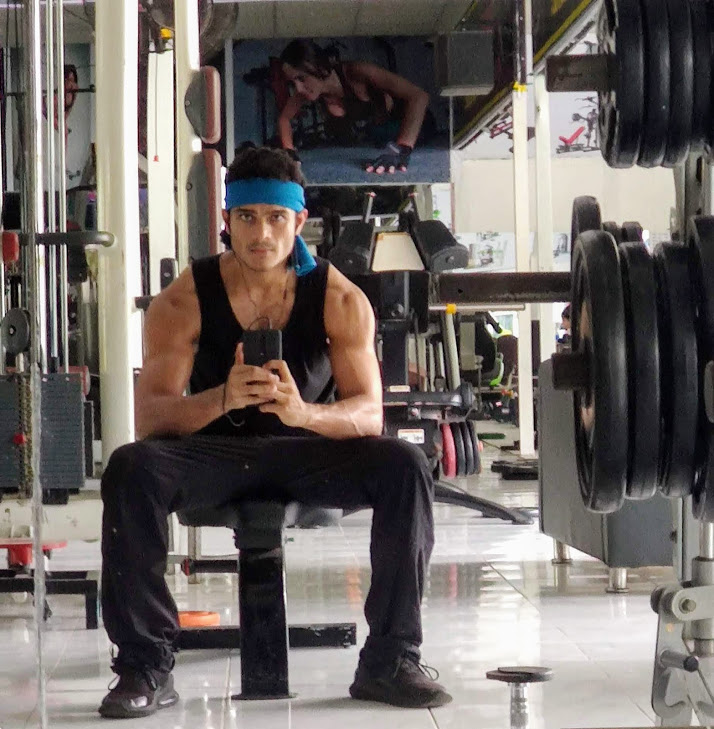
Fundamentally, you can perform any exercises in the gym that help you cover the key movement patterns we have.
Key Movement Patterns:
- Horizontal pushing (like chest press)
- Vertical pulling (like shoulder press)
- Horizontal pulling (like barbell row)
- Vertical pulling (like pullups or lat pulldown)
- Lower body pushing (like squats)
- Lower body pulling (like deadlifts)
In terms of sets and reps (repetitions), I did 3 sets of 10 reps each and added volume over time usually in terms of weight).
Training Volume
The training volume can be defined by the following:
VOLUME = SETS X REPS X WEIGHT
I found it good to increase volume a little each week which is what I mentioned earlier in this post where I defined ‘Progressive overload’.
As per my research, you can lift heavy, moderate or light based on your goals as follows:
- STRENGTH: 3-5 SETS OF 3-5 REPS EACH
- HYPERTROPHY: 3-4 SETS OF 8-12 REPS EACH
- ENDURANCE: SETS OF 15+ REPS EACH
I liked the Hypertrophy range as it was the most practical for me and also covered all the fundamentals. So you just need to adjust the weight to match the sets+rep ranges you can execute at the gym.
It’s also good to understand the role of each muscle group and what functions they perform:
- Delts / Shoulders – side lifting movements
- Biceps – controls both shoulder and elbow motion
- Triceps – stabilizes the shoulder joint and allows the elbow joints to be straightened
- Pecs / Chest – Involved in shoulder joint movements
- Abdominals (everyone’s favorite muscle group!) – Assists in breathing and protecting inner organs, supports bending motions
- Obliques – twisting and rotating bends, helps support the spine from the front body
- Traps – below the shoulders on the back, they are used to tilt the head and the neck
- Lats – large muscles below the raps, used when you pull something toward the body, also involved in swimming
- Erector Spine – Located below the lats, helps in extending the spine like when you do the cobra pose in yoga
- Glutes – the butt muscles, they are key for the movements of the legs backward and sideways, they also maintain the body’s balance while walking, jogging, running
- Hamstrings – the upper back part of the legs, the main function is to bend the knees, they also help propel the body forward while walking, running, or jumping
- Calves – the lower back half of the legs, they are engaged when heels are lifted up, they are key in walking, running, going upstairs, hiking activities
- Quads – the upper front part of the legs, these are key muscles used to transition from sitting to standing, they help straighten the leg and stabilize the knee joint during movements
Muscles 1 through 6 make up your Front Upper Body, 7 through 9 make up your Back Upper Body, and 10 through 13 make your LOWER BODY.
PART 2: NUTRITION
“The best abs exercise is 10 sets of stop eating so much crap.”
The first mistake I made with managing my nutrition was starting with a list of foods I should EXCLUDE from my diet or even worse, excluding food groups from my diet.
My initial research led me to believe that all carbs were bad and were the enemy to progress. I realized soon this wasn’t the case and a healthy balanced eating style that covered all the nutrition the body needs, was better and more scalable.
I quit a lot of foods and then slowly added them back to my diet as I progressed on my fitness journey. There were only 2 things I didn’t feel like adding back after I’d been off them for 3 months:
- ALCOHOL
- SUGAR
While I can imagine myself having an occasional glass of wine or dessert on a special occasion, I don’t really feel like having any of those 2.
Back to our discussion on eating styles, I had started my experiments with ketosis, moved to low-carb, to carb cycling and now I eat whatever I want.
The important thing to note here is “whatever I want” now is very different from “what I wanted” earlier. Now, I always tend to pick a healthier choice on default mode without counting calories or marcos, and eat those things as much as I want.
As I mentioned, the exclusions list just creates boundaries on the brain so instead, it’s better to have an intuitive understanding of:
- Foods to eat more of
- Foods to eat some of
- Foods to eat less of
Making these lists will take the initial time and effort to understand:
- Calories
- Marcos
- Availability
- Cost vs Budget
- Taste preferences
And yes, this list is in the order of importance. Calories are important to maintain the energy balance the body needs. Marcos dig one level deeper. If something is not easily available and expensive, you should still try to get it if your health is high priority to you. And of course, taste preferences matter the least, at least for me, as I feel taste comes from marketing and we can change it using habits and start liking foods we want to like more than before.
“Remember: Nothing tastes as good as being healthy feels”
This is essentially the nutrition equivalent of favorable execution I spoke about in the training section.
The only thing you must consider as most important out of this list is food allergies or animal-based vs plant-based preferences. Of course, you can’t change food allergies and you probably already have a good reason to choose your intake of animal vs plant-based food so it goes without saying that you should look for food sources in your style.
I choose pescetarianism so my lists will be from plant, milk or seafood sources.
After a while on your fitness journey, you’ll have an intuitive understanding of the kinds of foods on these lists.
To give you an example, my lists are as follows:
FOODS ON MY LISTS
Foods to eat more of
- Salmon (my favorite fish)
- Eggs (my favorite go-to protein source)
- Berries (my favorite fruits)
- Walnuts, Macadamia Nuts (my favorite nuts)
- Green Leafy Vegetables (my favorite vegetables)
- Sweet Potatoes, Potatoes (my favorite carbs)
Foods to eat some of
- Soy-based products (Tofu, edamame, soy milk, etc)
- Other Fruits (Watermelon, Banana, Mango, Kiwi, etc)
- Other Nuts (Almonds, Cashews, Peanuts, etc)
- Milk and Milk Products (Yoghurt, Cheese)
- Protein Powder
- Rice, Whole wheat, Bread
- Any Shellfish
- All other fish (Pomfret, Snapper, Tuna, etc)
- All other vegetables (Eat the rainbow)
- Extra Virgin olive oil or coconut oil
- All kinds of lentils and beans
Foods to eat less of
- All fast food
- All packaged food
- Other oils
As you’ve seen, I mention all the foods for nutrition but not drinks. I would always prefer to eat fruit rather than to drink fruit juice and I mostly avoid drinks except what I really love that is:
- Water
- Tea
I like all kinds of teas – hot or cold – green, oolong, white, silver, red, black – all of them.
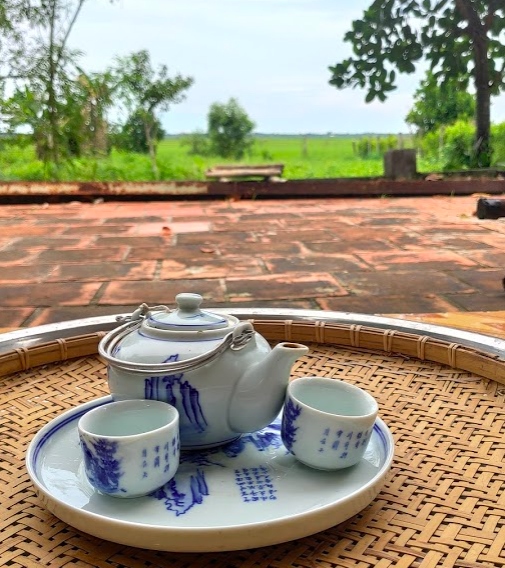
Red Oolong has become one of my top favorites currently. It has the right level of oxidation and flavor I need from a hot cup of tea. In the morning, I usually prefer ginger in my tea.
And of course, I never sugar-down or milk-down my tea so it’s just with water.
MEAL PLANNING
After a lot of trial and error, I finally found the magic formula for planning my meals.
The formula is based on the VISUAL distribution of food on the plate and it is as follows:
- 50% of the plate should be VEGETABLES
- 25% of the plate should be PROTEINS
- 25% of the plate should be CARBS
And that’s all. The FATS will be covered during the cooking and the nut-snacking in between. But let’s see how this could look like:
MEAL EXAMPLE 1:
- 200 grams of Salmon
- 500 grams of Spinach
- 2 Sweet Potatoes or potatoes
The Salmon and Spinach will be cooked with extra virgin olive oil or coconut oil and the sweet potatoes will be boiled.
This would be an ideal meal for me at any time of the day.
MEAL EXAMPLE 2:
- 5 eggs (cooked any way)
- 500 grams of morning glory
- 1 Asian-sized rice cup or rice noodles
Here’s another ideal meal for me.
MEAL EXAMPLE 3:
- A baguette
- Filled with 500 grams of Malabar spinach
- 3 eggs inside
- 2 low-fat cheese slides
This meal would fall into my eating “some of” list while EXAMPLE 1 and 2 would be absolutely on my eat “more of” list.
As you notice, all the above 3 meals follow the 25%/25%/50% rule. To repeat that, it’s 25% protein, 25% carbs, and 25% veggies.
Note that most blogs mention the rule as 25% protein, 25% grains, and 50% vegetables.
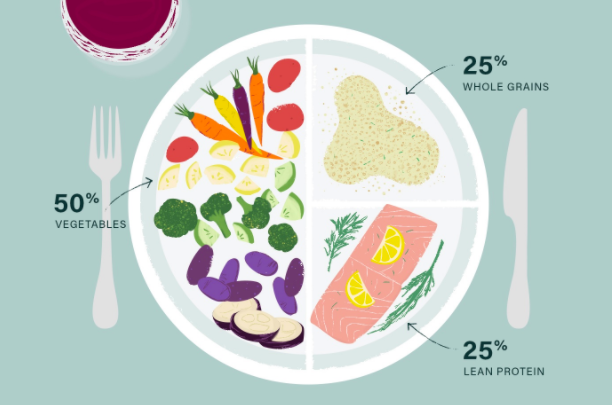
I’ve just switched the 25% grains with 25% carbs so that could be grains or even vegetables such as potatoes and sweet potatoes.
For me, potatoes and sweet potatoes are replacements for rice and bread and I don’t count them so much as vegetables. Vegetables for me mostly mean green leafy vegetables.
VISUAL MEAL PLANNING EXAMPLE
I’ve repeated combinations from the above list based on the 25/25/50 rule almost every day. On most days, I would eat from the list ‘foods to eat more of’ and sometimes combine them with ‘foods to eat some of’.
In fact, if you put my meals together in one place, you won’t see a huge difference between meals. This helped me manage time and energy.
I’d like a nice piece of salmon that’s not too pink inside and yet isn’t too dry or crisp either. – Bob Saget
Here are some meals on different days of my favorite 25/25/50 combo:
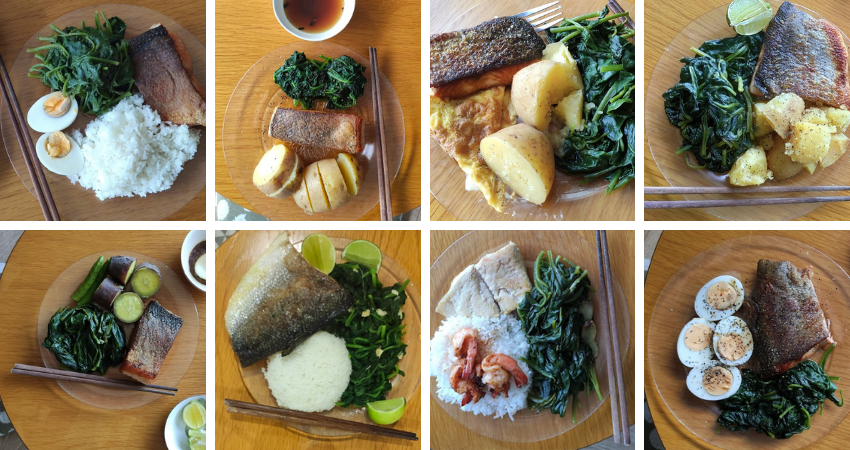
I find this meal combo so tasty that I often repeat it and have never gotten bored eating it for the past 10 months. Within a few weeks of experimenting, you will also find your go-to combo.
And the best part is, you don’t need to follow it every day. Just stick to the 25/25/50 golden rule and you’ll be fine.
Of course, not all my meals look like this and I do go out. I try to make the best choices while eating out.
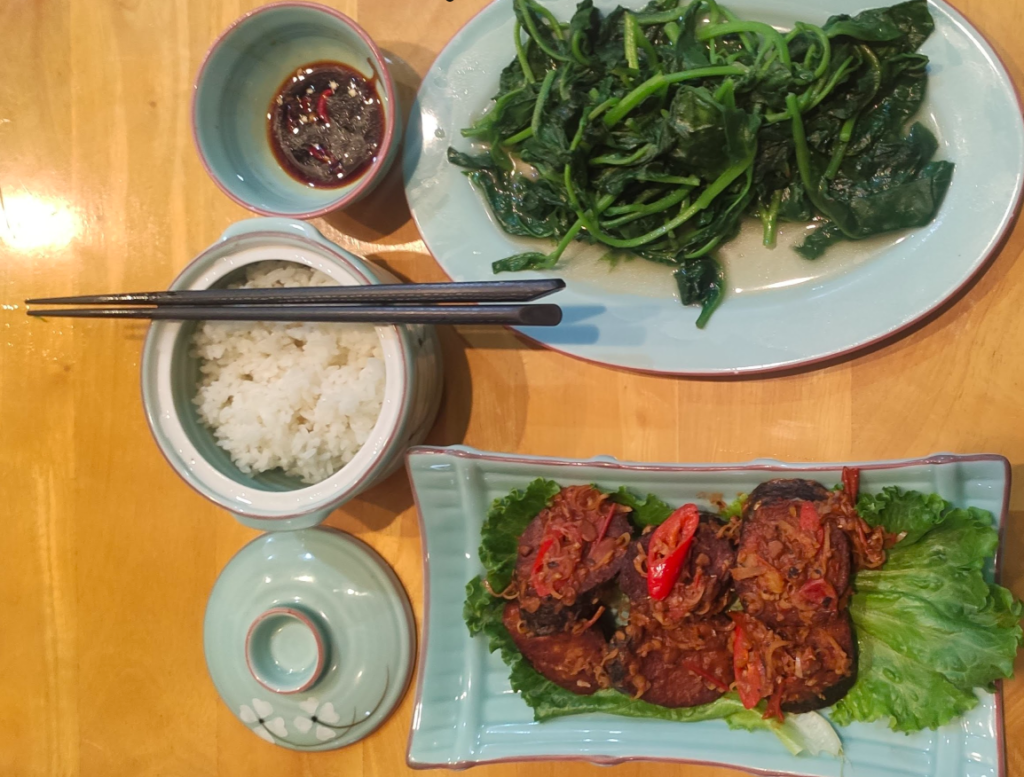
I usually pick seafood restaurants on days I decide to eat out so I can eat many things I wouldn’t otherwise cook at home for a change.
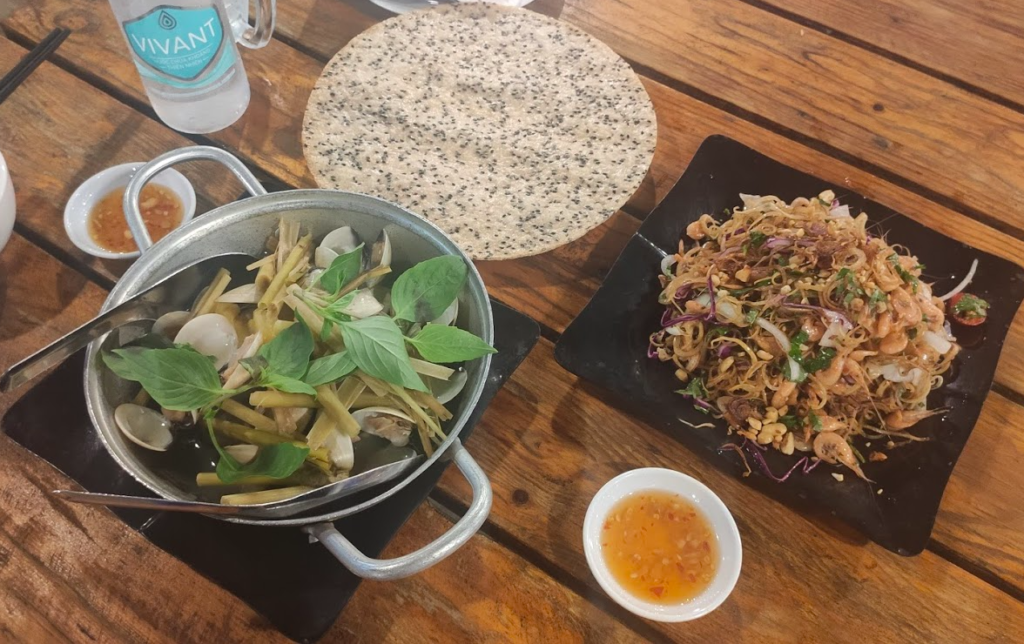
I also enjoy BBQ and grill as they’re very healthy and tasty options to get in the proteins and veggies.
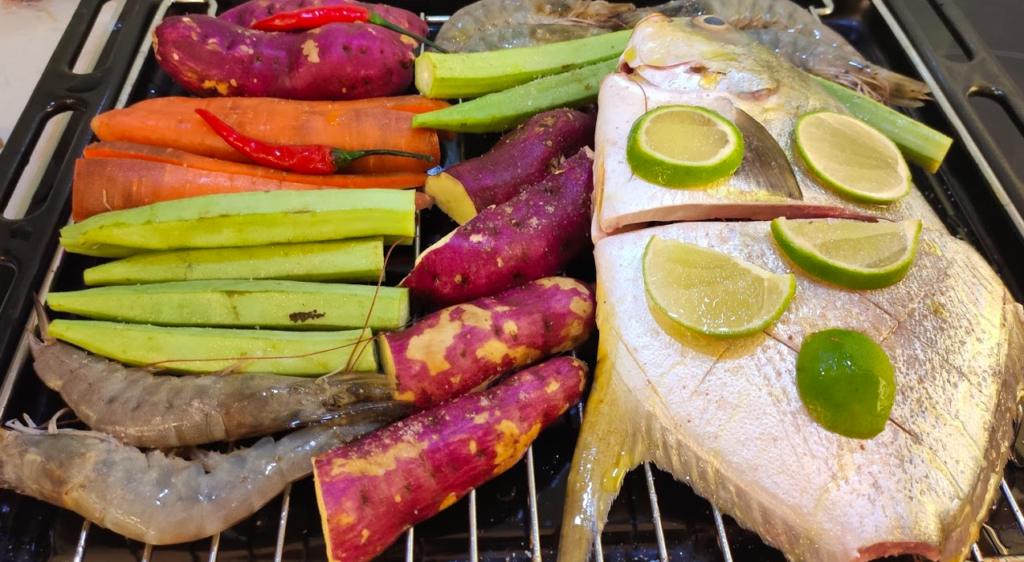
Trying different salads and soups is something I enjoy when I go out as I usually don’t prepare salads and soups at home. This makes for a good change..
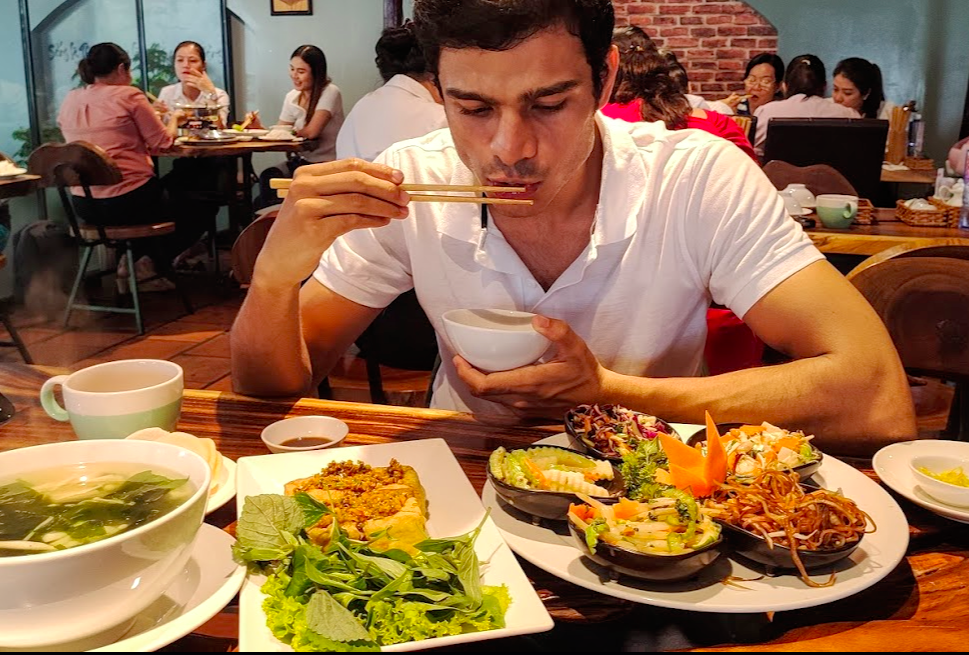
Japanese restaurants are also usually a very safe post-workout meal option – I especially enjoy them for dinner.

MEAL AND TRAINING SCHEDULE
“Never eat more than you can lift” – Miss Piggy
In terms of scheduling and volume of meals, I try to eat 2 main meals every day which is as explained above + 2 protein-powder-based meals which total to around 4 meals a day.
Each Meal mentioned below has 30 grams of protein making my total for the day at 120 grams of protein which is my goal based on my current weight.
There is at least a 3 hours gap between each of the meal to ensure the body can use the protein taken in the last meal before we go for the next one.
- Meal 1: Between 8:00-9:00 AM (Either Yogurt or Milk with Protein Powder and Fruits)
- Meal 2: Between 11:00 am to 12:00 noon (25/25/50 Meal)
- Meal 3: Between 3:00 pm to 4:00 pm (Either Yogurt or Milk with Protein Powder and Fruits)
- Meal 4: Between 7:00 pm to 8:00 pm (25/25/50 Meal)
On some days, when I have more time and feel like it, I will make 3 meals 25/25/50 meals, and only 1 protein-powder based meal. And if I’m traveling, which I am most of the time, I don’t carry my protein powder and hence get all 4 meals from real food sources.
That being said, protein powder is great and convenient and it’s nothing to be scared of. On the other hand, even natural whole food sources have reasons to be scared of these days 🙂
In case you’re curious when I train, it’s usually before Meal 1 around 7:00 AM (first training) and after Meal 3 at around 5:00 PM (second training). I train twice a day every day. If I’m doing weight training in the morning, then I will do slow and simple steady-state cardio or yoga in the evening. On some days, I do yoga in the morning and calisthenics in the evening. So I mix it up with 1 low-intensity session and 1 heavy session each day.
Sometimes I drink another glass of milk before sleeping. In all the above options, milk can be either dairy milk or almond milk or soy milk or walnut milk. I don’t like the taste of soy milk so much so I use either regular milk or almond/walnut milk. The yogurt I prefer is greek yogurt otherwise regular yogurt is fine. Of course, everything without added sugar.
I target 0.8 to 1 grams of protein per gram of body weight and only count the main protein sources – not the extra protein in the spinach, milk, cheese, etc which would also be adding up. Protein is the macro that I don’t mind getting more of.
It is really the MOST IMPORTANT MACRO in our meals.
PROTEIN: THE MOST IMPORTANT MACRO
When it comes to nutrition “counting”, I rarely count calories or other macros now as I have an intuitive eating style. However, the only thing I do count is PROTEIN.

An egg is always an adventure; the next one may be different. – Oscar Wilde
It is really the most important macronutrient. If you have enough Protein, you can afford to balance carbs and fats with whatever else is in your day of eating.
What is Protein?
Basically, protein has 20+ amino acids which are its building blocks. We don’t store amino acids in our bodies but the body can make them itself. To make all the amino acids, the body needs 9 of them called essential amino acids as input.
This means that these 9 amino acids must come from food. Here is the list:
- Histidine
- Isoleucine
- Leucine
- Lysine
- Methionine
- Phenylalanine
- Threonine
- Tryptophan
- Valine
Your body will then use all the amino acids to build and repair muscles and bones and to make hormones and enzymes. The muscle repair process, for example, that is fueled by protein+recovery is what makes muscles grow.
There are foods in which all the 9 essential amino acids listed above are present in sufficient quantities. These food sources are called ‘complete protein’ food sources.
Complete Protein Food Sources:
- Meat
- Fish
- Eggs
- Dairy
- Soybean
On a vegan/vegetarian eating, other than soy, you will have to combine incomplete protein sources together to make complete proteins. A few examples are nuts + whole grains OR beans + whole grains OR beans + nuts.
As I mentioned in the section above, I target 0.8 to 1 grams of protein per gram of body weight and I don’t mind getting in extra protein.
SUPPLEMENTS
After a lot of research, there are only 2 supplements I found worth consuming, useful, and well-studied:
- Protein Powder
- Creatine Powder
That’s all. No BCAAs and gainer powders, etc. Just any protein powder with low sugar content and micronized creatine. Those are the only 2 supplements I use.
Protein Powder is not as much of a supplement as a convenient alternative to the meals. As mentioned, I use it with milk or yogurt along with some fruits.
The fruits make it feel like real food which I like.
You can do read further on creatine here.
PART 3: RECOVERY
Recovery is different from what we usually think of as “rest”. Recovery is getting your body back to the neutral condition of being ready to perform training.
While some would consider watching TV and drinking beer as “rest”, it may not be leading to Recovery.
Rest could be based on individual choice but recovery is a scientific process. There are many ways to get recovery based on your training.
Let’s look at the components of recovery and some techniques for recovery:
SLEEP
Sleep is, undoubtedly, the biggest component of recovery.
”Sleep is an investment in the energy you need to be effective tomorrow.” – Tom Roth
And it’s not just about the quantity but the quality of sleep.
I try to get 7 hours of sleep in the night and a 1-hour nap in the afternoons. In the nights, my sleep schedule is usually to sleep from 10 pm to 5 am but it varies based on how the day is packed.
The nap is a post meal 1 hour siesta in the day which further helps recovery.
”Never waste any time you can spend sleeping.” – Frank H. Knight
NUTRITION
While Nutrition has been discussed as an independent pillar of fitness, it also forms a big part of RECOVERY.
While recovering, we shouldn’t ignore that our bodies still need all the right nutrition.
MASSAGE
One of my favorite tools for recovery and the one I feel most relaxed with is getting a massage. Deep tissue massages are quite useful for training recovery.

And since I live in Asia, massages are quite accessible to me.
HOT TUB
After my workouts, I like to take a cold shower followed by a warm water hot tub immersion session until my heart rate comes back to normal completely and I feel totally relaxed.
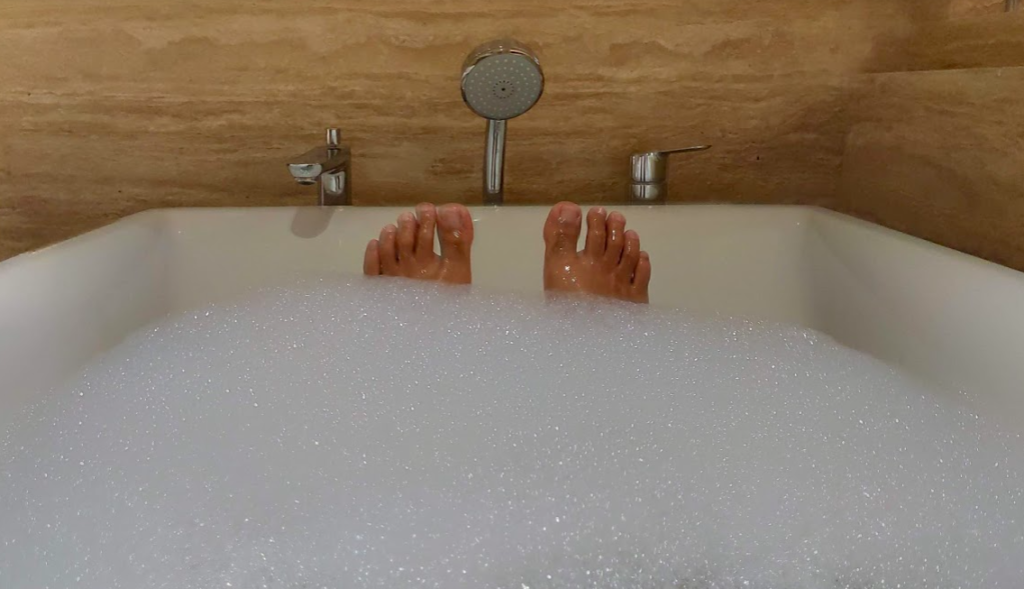
This usually means around 15 minutes (or more!) in the hot tub.
ACTIVE RECOVERY: WALKING, JOGGING, CYCLING, SWIMMING
Recovery can also be active. After a good strength training or calisthenics session in the morning, I like to recover with a slow jog or walk or swim in the evenings.
The jogging pace is normal where I can easily hold a conversation and focus on my breathing.
STRETCHING
While I ignored this in the initial few months of my fitness journey, now I understand the importance of stretching.
I stretch around 15 minutes after each training session. Mostly, I follow my yoga stretches here.
I have also included dynamic warm ups before each training session.
Those are some of my favorite techniques for recovery that I’ve implemented in my fitness routine. That being said, I do workout every day and I don’t feel the need of waiting for more than 24 hours between workouts. What I do instead is vary the intensity and have high volume sessions on alternative days while low volume sessions on the rest.
I also have focus days on PUSH, PULL, LEGS so the muscle groups take turns and get enough time to recover. Another method I use is to take a week off after each month of workout where I still focus on Nutrition and Recovery but cut down strength training and do only yoga and some calisthenics.
This is somewhat like a de-load week except I’m still quite active but I feel completely recovered when I’m back to the gym after this week.
This has been my fitness journey so far and I’ll be happy to keep this guide updated in order to keep documenting my learning for my own reference in the future as well as to share them with you. I wish you all the best on your fitness journey!
“Train Like An Athlete, Eat Like A Nutritionist, Sleep Like A Baby, Win Like A Champion”
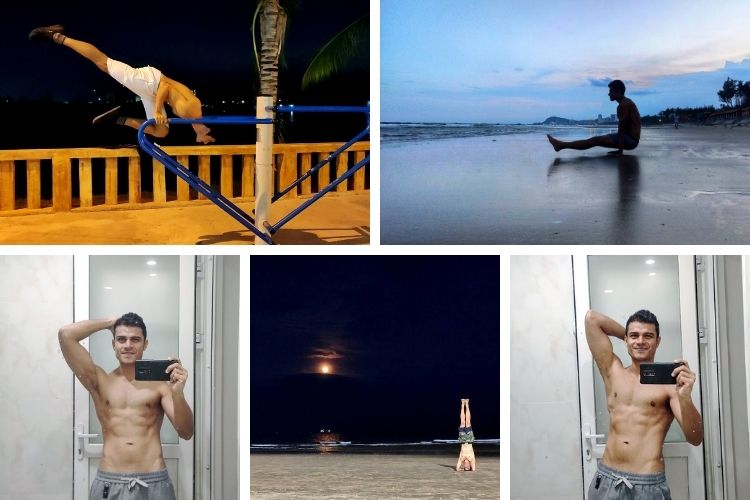
Love this! Thank you for sharing such an insightful article!
So inspiring. Really like the way you’ve broken down the details on every aspect of fitness. Thank you for sharing!
WOW! You indeed r great Sir! What serene knowledge
Wow, this blog is an amazing guide for anyone starting their fitness journey! The tips on training, nutrition, and recovery are so helpful and easy to understand. It’s like having a personal coach in one place. Thanks for sharing your knowledge!